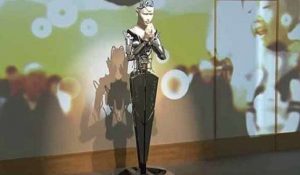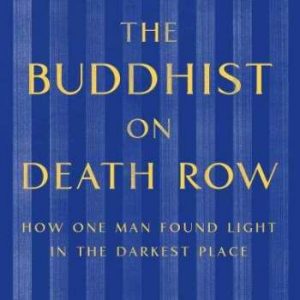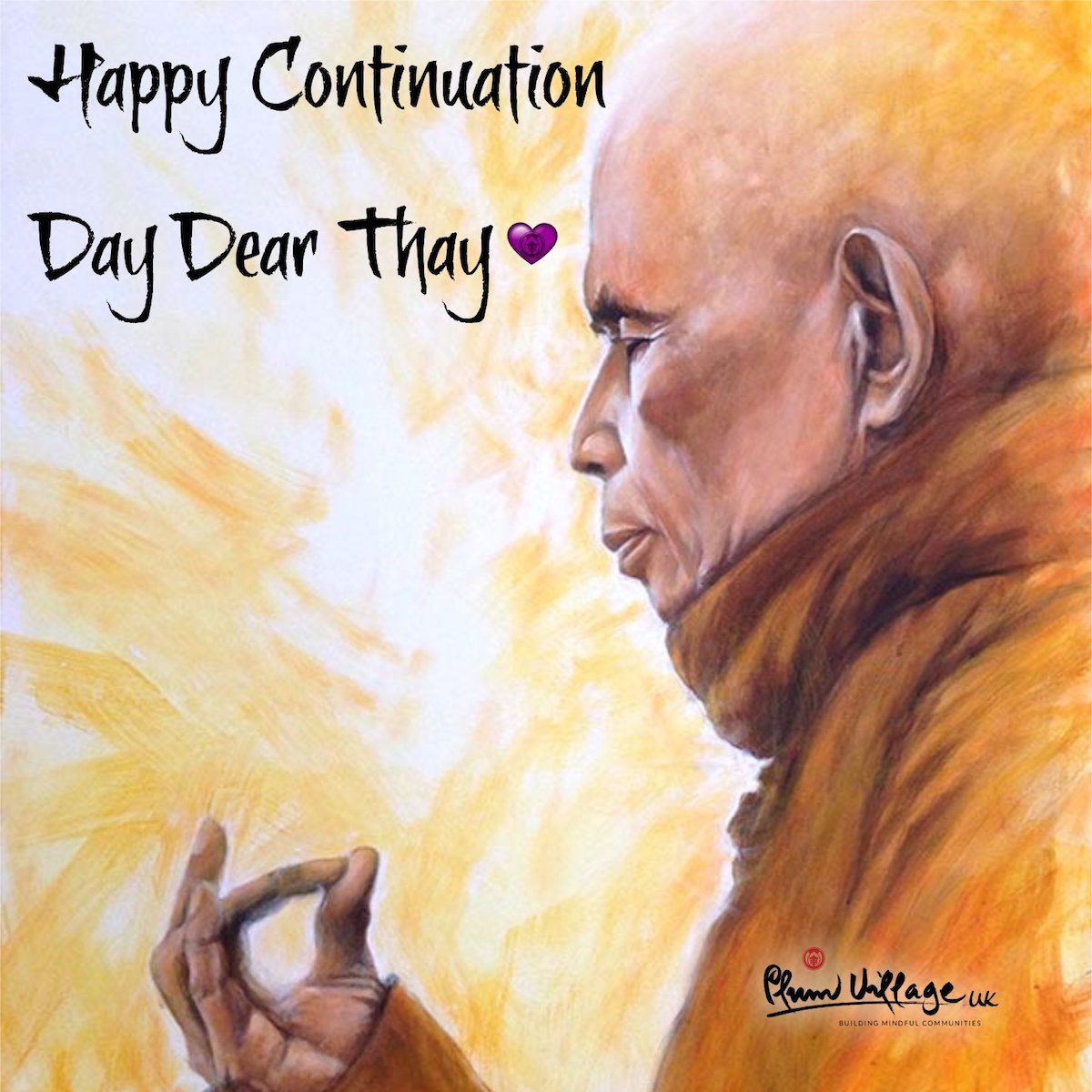
Followers and admirers around the world of the Vietnamese Zen master Thich Nhat Hanh marked the revered Buddhist teacher’s 94th birthday—or Continuation Day—on Sunday. Thich Nhat Hanh, known affectionately to his students as “Thay” (teacher), now resides at his root monastery Tu Hieu in Vietnam’s Hue Province, where he is cared for by close disciples.
Marking the occasion, Thay’s Plum Village monastic community in southern France shared a selection of personal accounts from fellow students of Thich Nhat Hanh, who expressed their gratitude as well as “stories of transformation, reconciliation and journeys out of sadness and despair.” (Plum Village)
As his monastic disciples, every year around this time we would ask Thay or ask his attendants what Thay needs or would like to have for his birthday. Thay, having lived a monastic vow of simplicity all his life would almost always reply that the best gift you can offer him is not anything material, but to hear how practising the Dharma has helped you to transform your suffering into peace, joy and happiness, or how you have reconciled with your family, touched your friends and those around you with your practice of mindfulness, loving kindness and compassion. (Plum Village)
Thich Nhat Hanh returned to his homeland Vietnam in October 2018 from Thailand, where he had been convalescing since late December 2016 following a severe stroke in 2014.* The celebrated Zen master said in a letter to his disciples at the time that he had decided to live the remainder of his life at his root monastery, Tu Hieu Temple, in the central Vietnamese city of Hue, where he was ordained as a novice monk at the age of 16.
Last week, Plum Village also published a statement to reassure the global Buddhist community, following reports circulated on social media that the revered monk’s health had deteriorated. “We are happy to confirm that Thay’s health currently remains stable, thanks to the love and care of his medical team and monastic attendants. There is no immediate cause for concern,” Plum Village confirmed in the statement dated 6 October. “The elder brothers who are traveling from Thay’s international centers to see Thay have arrived safely in Vietnam and are now in quarantine, and are looking forward to seeing Thay soon.” (Plum Village)
Noting preparations for Thay’s approaching birthday, Plum Village added: “We encourage you to put Thay’s teachings into practice, and take this moment to help you find the courage and compassion to reconcile with someone you have difficulties with. This is the best gift we can offer our Teacher.” (Plum Village)
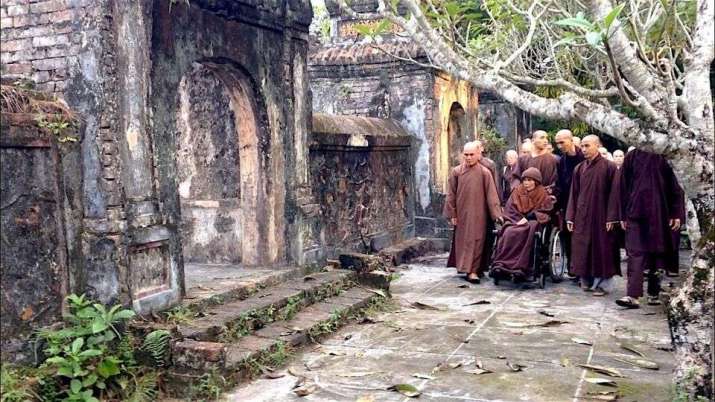
In November 2014, Thay was hospitalized in France following a severe brain hemorrhage. After months of rehabilitation, he returned to his Plum Village monastic community in April 2015, where attendants from the monastery and visiting medical professionals continued to aid his recovery. In July of the same year, Thay was flown to San Francisco to undergo a more intensive rehabilitation program. In September 2015, Thay spoke his first words since his stroke and in the following January he was allowed to return to Plum Village, where he remained under the care of the members of his community.
In December 2016, two months after his 90th birthday, Thay communicated a clear and determined wish to travel from France to Thailand in order to be closer to his homeland.* In August 2017, Thay made his first visit to his homeland Vietnam in more than a decade, spending several days in Da Nang before visiting his hometown in nearby Hue and paying his respects at his ancestral shrine and his lineage’s root temple, Tu Hieu, of which he remains the abbot.
One senior monastic disciple, Brother Chan Phap Dung, recalled a powerful teaching shared by Thay before he became sick, in which he instructed his community not to build a traditional memorial stupa for his remains after he dies:
“Please do not build a stupa for me. Please do not put my ashes in a vase, lock me inside and limit who I am. I know this will be difficult for some of you. If you must build a stupa though, please make sure that you put a sign on it that says, ‘I am not in here.’ In addition, you can also put another sign that says, ‘I am not out there either,’ and a third sign that says, ‘If I am anywhere, it is in your mindful breathing and in your peaceful steps.’” (Plum Village)
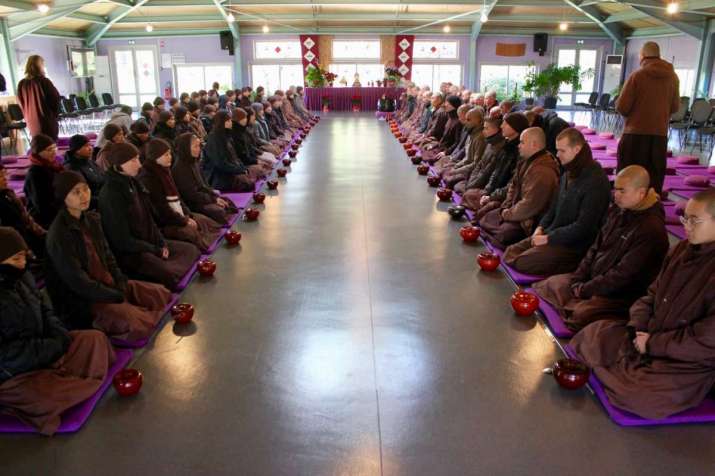
Born Nguyen Xuan Bao in central Vietnam on 11 October 1926, Thay is an influential Zen teacher, poet, and the author of more than 100 books, including the bestselling The Miracle of Mindfulness. As an active advocate for peace, he was influential in the anti-war movement, encouraging non-violent protests during the Vietnam War. Before leaving Vietnam, he spearheaded a movement by Buddhists in the south calling for a negotiated end to the bloody conflict. In 1967, he was nominated for the Nobel Peace Prize by Martin Luther King, Jr., who told the Nobel committee: “I do not personally know of anyone more worthy of the Nobel Peace Prize than this gentle Buddhist monk from Vietnam.” (Plum Village)
Thay founded the Order of Interbeing and the Unified Buddhist Church, and in 1982 established the Plum Village Buddhist Center in France with Sister Chan Khong. He has been a central figure in the transmission of Buddhism to the West and in marrying an authentic Zen tradition and lineage with a progressive approach to issues such as social activism, science versus faith, and religion versus spirituality.
* Thich Nhat Hanh Returns to His Roots in Vietnam (Buddhistdoor Global)
See more
Happy Contination Day Thay – Thank You! (Plum Village)
Latest News of Thầy’s Health in Huế (Plum Village)
A gift for Thay (Plum Village)
Thich Nhat Hanh’s final mindfulness lesson: how to die peacefully (Plum Village)
Plum Village









